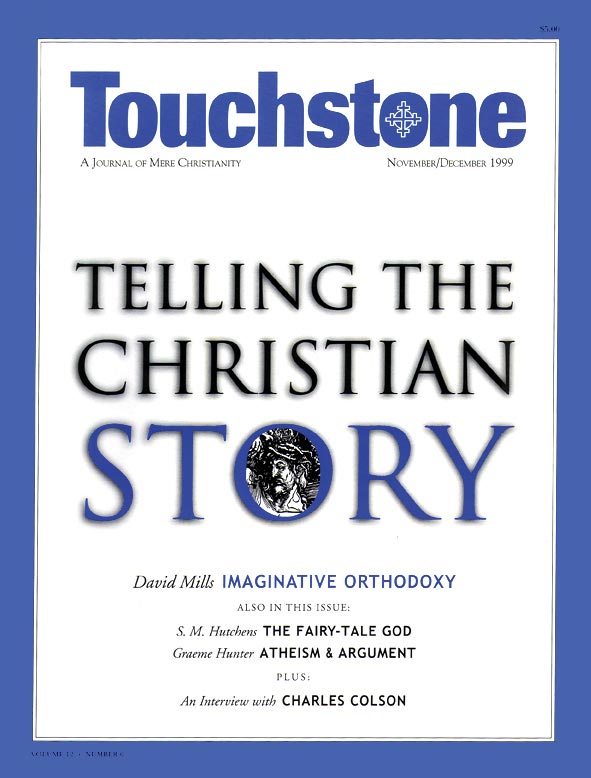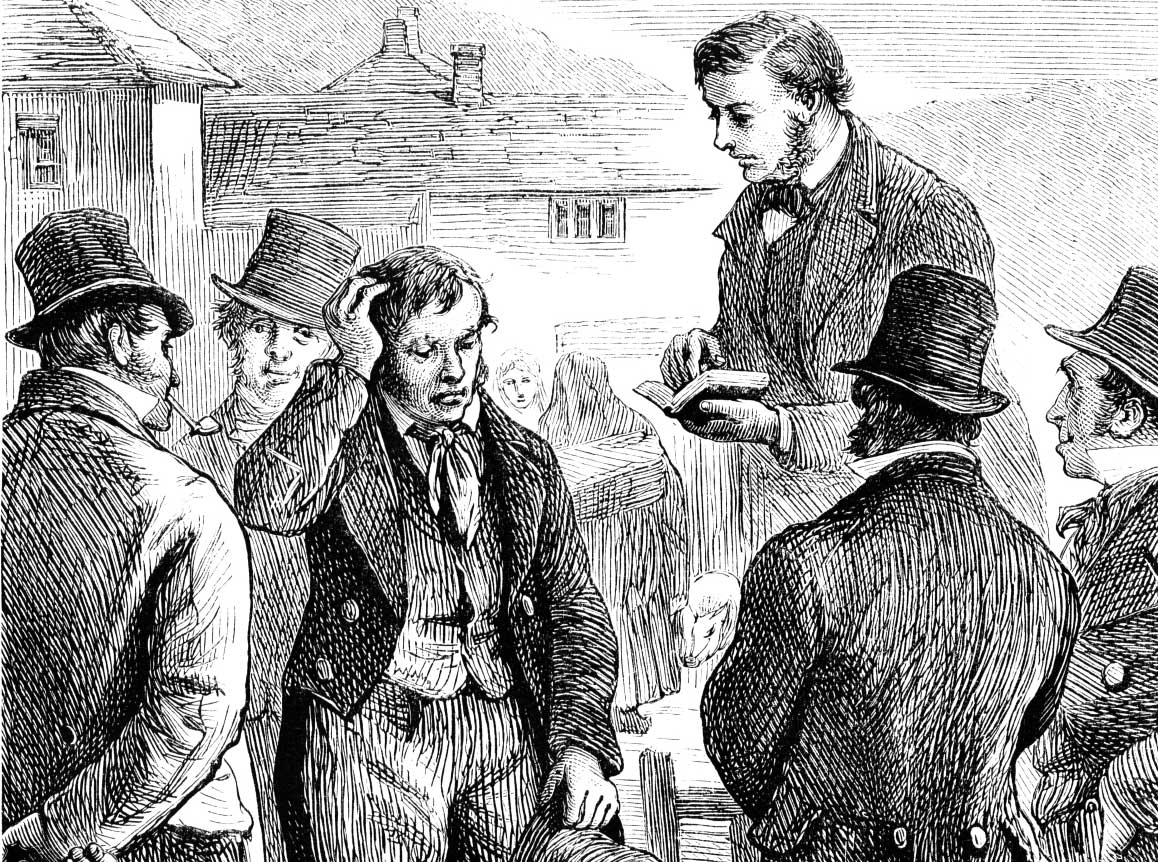The Fairy-Tale God
Truth & Deceit in Children’s Fiction
by S. M. Hutchens
My girls are no longer young, but when they were, I paid some attention to the children’s books they brought home from the library. Martha and Laura had orthodox tastes, and no interest in anything weirder than Dr. Seuss. Every now and then, however, they would bring home something that struck me as more than odd, but bad, and on rarer occasions more than bad, but genuinely evil. I began to keep my eyes open.
When I began to work as a librarian, cover art and titles of children’s books that looked a bit “off” attracted my attention. So did the popular literature of professional librarianship, which indicated that there was deep moral sickness in the library world. Marian the Librarian, it turned out, was a very accurate stereotype of a person all too common in the libraries: the modestly educated libertine with a firm belief in her intellectual superiority and zeal to enlighten the local clodhoppers to the point where they can recognize it.
Marian has come into her own in our day, and she is going after the bourgeois prigs in River City with a vengeance. Exposing the village children to Rabelais and Balzac is no longer enough. She is now on to everything that Michael and Diane Medved have said, in Saving Childhood, corrupts the happiness of innocence. The American Library Association, Marian’s political arm, in league with the ACLU and the like, is fighting and winning major court battles against a community’s right to filter its public library’s Internet connection, and thus is making everything imaginable, and some things that aren’t, available to every patron who can operate a computer. Vigilant parents can protect young children from Internet pornography to approximately the same degree they could from dirty pictures that got handed around the playground in the old days, which is to say, some, but not completely. Such things have always been in the world, and innocence is still its own best protection. People don’t get corrupted unless they wish to be.
I am concerned here with something more subtle, something that encourages despair more than lust, and is more difficult to detect and fend off. I refer to the numerous attempts by modern tellers of tales to impress into children’s minds stories that are what Lewis’s hrossa called “bent”—twisted accounts of what is and what should be—and to convince those who read them to children that these stories are just the things they ought to hear. Stories are images of reality that invite participation of the hearer’s imagination. They have an attractive power that invites us to take part in them, to find our places in the story’s world. Bent stories are bad places to wander into, for, made as they are from stolen bits of heaven, they hold out the promise of something good, but subject the imagination, once it is captured, to the philosophy of hell.
Tales for Our Time
Several months ago while browsing in the bookstore Half Price Books, I found an interesting collection of stories that I decided on the spot was indeed worth half price, and bought it, mostly on the basis of its fascinating title and cover illustration. On the cover of The Outspoken Princess and the Gentle Knight is a little girl with firmly planted feet, right arm akimbo, and in her left hand a golden sword. Bowing humbly at her feet is a king whose own sword has been placed on the ground. (This is one tough kid, who obviously never learned that only boys carry swords.) The editor, Jack Zipes, was at the time of publication a professor of German at the University of Minnesota, whose books include Fairy Tales and the Art of Subversion and Don’t Bet on the Prince: Contemporary Feminist Fairy Tales in North America and England.
In the introduction, Professor Zipes tells us that there are problems with the magic of the traditional fairy-tale collections. We don’t “pause to think that many of the tales that have become part of the classical canon like ‘Snow White,’ ‘Sleeping Beauty,’ and ‘Cinderella’ may have dubious messages when it comes to the depiction of gender roles, violence, and democracy.” “Since,” he says, “we tend to internalize the values we were exposed to as children without seriously questioning them, there is a danger that we may perpetuate the cultural and political messages of traditional fairy tales rather than seek out tales more appropriate to the social temper of our times.”
Up until relatively recently similar tales continued to “provide glimpses of happy heterosexual marriages, stable class systems, and successful heroes with wealth and power that may have been satisfactory for patriarchal world orders, but they offer very little hope for change in view of present day conditions and upheavals.” In other words, what is both right and possible for the imagination changes with the times. Its life should mutate to reflect as much hope for happiness as the times permit, and in accordance with the wisdom of the new age. Fairy tales, says Professor Zipes, reflect utopia, a place we envision in our dreams. It constantly shifts its shape and meaning, depending on the real conditions of our society.
With an introduction so philosophically shallow and morally perverse (as though there were no perduring desires of the human heart, as though some utopias aren’t dreams of terror, as though we must bow to “progress”), you can imagine what I expected to find in this book. What was actually there, however, surprised me, and brought me to wonder whether it is in fact very easy to “bend” a tale in accordance with the editor’s belief that societal changes could and should affect what the imagination craves. If fathers are in short supply in the ghetto, and whole marriages are rare in the suburbs, does this mean that children, directed by radical scholars, can or should quit entertaining the imagination of strong kings who reign with their queens, who love them and destroy what threatens them? To be sure, there were what appeared to be a number of attempts to do that kind of thing here, and some got the message across quite clearly. But others didn’t seem to work too well—and some of the tales selected by the editor, apparently on the basis that they were counter-cultural, drifted against the culture in very good ways. One expected an entirely bad show; what turned up in fact was a very mixed bag.
Evading Wolves
In The Uses of Enchantment, Bruno Bettelheim observes that “Little Red Riding Hood” has helped children, girls in particular, come to grips with their fears of danger in the real world, particularly that presented by the sexual predator who will certainly eat her up, as it were, if he is given the chance, and yet has given hope and comfort to even those who have been “eaten” that there is a redeemer—a huntsman—who has the power to slay the wolf and set them free. Here is, that is to say, an encapsulated story of sin and redemption of great sophistication and symbolic depth, combined with a valuable cautionary tale.
Witness in contrast Catherine Storr’s contribution to the Zipes anthology, “Little Polly Riding Hood.” Polly doesn’t live in a forest. Hardly anybody does anymore, you know. She lives in the middle of a big city. There is a wolf there, and he is interested in having Polly for dinner, but he is an effete and bumbling anachronism. Polly regularly escapes him by such clever ploys as taking the bus, on which he can’t follow her because he hasn’t any money, or having her father drive her to grandma’s. After numerous rebuffs to the wolf, the tale ends this way:
“Bother, bother, bother, and bother!” said the wolf. “It hasn’t worked out right this time either. And I did just what it said in the book. Why can’t I ever get you, Polly, when that other wolf managed to get his little girl?” “Because this isn’t a fairy story,” said Polly, “and I’m not Little Red Riding Hood. I am Polly, and I can always escape from you, Wolf, however much you try to catch me.” “Clever Polly,” said Polly’s grandma. And the Wolf went growling away.
And that’s that.
So the child reading this story is assured that there are not any real wolves in big cities, but even if there were, they can be escaped with ease. And why? “Because I am Polly,” says the child. Clever author. As for myself, I will confess that in my own perverse moments I have been tempted to commend “Little Polly Riding Hood” to whomever it interests, since any brat who finds the story appealing will be eliminated in due course by the wolves, and won’t likely be missed.
The Gentle Knight & The Faithful Bull
Richard Schickel’s “The Gentle Knight” is about a nineties-kind-of-knight named Freddy who is more interested in reciting poetry than slaying dragons. Because of his station, however, he is expected by his people to do his draconicidal duty. A dragon is allegedly terrorizing the land, and Sir Freddy is dispatched to deal with it. He finds the dragon at the edge of a precipice, ready to leap over and end it all, since he is so lonely. The dragon, named Charley, is, as the reader fully expects by now, as harmless as the above-mentioned wolf, has never killed anyone, and breathes fire because of his irresistible craving for hot pepper seeds. He is a polite listener to Freddy’s poetry, and turns out to be a good companion. No, it is not a gay tale, for Freddy eventually finds a princess and marries her. He and the dragon save her from a lowbrow creature called the Huff by outsmarting it—no violence is necessary. They and the dragon become traveling players who eventually end up in Freddy’s old fiefdom, where the townspeople, who in Freddy’s absence have undergone a conversion to a more liberal frame of mind, urge them to stay. They do, and live happily ever after.
Well, that’s nice, isn’t it? As in the case of Polly and her idiotic wolf, there is no real danger in the world for which the shedding of blood might be necessary. This is, of course, the anti-Christian aspect of stories written from the privileged standpoint of those who can’t imagine anything serious enough to kill or be killed for. The redemption of the world is in Niceness, give peace a chance, and phooey, phooey, phooey, on anyone who thinks otherwise. Other than that, the story’s main fault is that it is boring. I can’t imagine any red-blooded boy who would want to hear this one twice, since he knows perfectly well that dragons are wicked and must die. Killing them is the most adventurous and satisfying work a man can do. Every normal boy—even the boy who likes poetry—wants to grow up to be a dragon-slayer, and will be, unless he is first captured and emasculated by his enemies.
Ernest Hemingway’s “The Faithful Bull” is an odd but touching little story of a bull who, entirely in character for a bull—and for Hemingway—loved to fight. “Anything made him want to fight and he would fight with deadly seriousness exactly as some people read or go to church. . . . He was not a bully nor was he wicked, but he liked to fight as men might like to sing or be the King or the President. . . . Fighting was his obligation and his duty and his joy.” His owner was a good man and wanted to keep this vigorous blood in his herd, so he did not sell the bull to the ring, but put him out to stud. Now here is the strange turn: the good bull, while remaining a fighting bull, becomes like a good man. He is not interested in serving the whole herd, but falls in love with a single cow and is faithful to her. This makes him useless to his owner, who reluctantly sells him to the ring, where he is killed. Hemingway has created a Christian knight—a Christ figure, in fact—who can be beloved of men and women. Perhaps he appears in this book because it is thought that in patriarchal literature the promiscuous man is glorified. Well, in some of it he is, but the Christian hero, like Hemingway’s good bull, is chaste.
Gender Benders
Sexual stereotyping—the wrongness of—is a major theme in these stories. I am not quick to write off stereotypes, for many of these are based on truths that the characterized find unpalatable. (When St. Paul called the Cretans lazy gluttons, he wisely defended it by a frank citation from one of their own poets.) What is known and admitted within a stereotyped group takes on another flavor when it come from outside, but this does not eliminate whatever truth might lie behind the stereotype. The rules that stereotypes imply, however, have exceptions, and truth is served by pointing them out. Witness “The Wrestling Princess” by Judy Corbalis.
At first stop, it appears just another one of the I-Am-Woman-Hear-Me-Roar stories. The heroine is a princess, homely but strong, who isn’t interested in girl-things, but likes to wrestle and work on forklift trucks. She is very good at both, and beats out all the men she faces in contests of skill and strength. OK, OK, one says to oneself, here is another feminist entertaining herself with luscious improbabilities—a woman who excels in physical strength and mechanical aptitude, two areas in which men in general are measurably superior to women in general. This doesn’t rule out strong women mechanics, of course, for there are a few of them out there. But those with a better grip on the shape of reality know that in contests of the sort wrestling princesses favor, the woman will soon enough get beat by a man. And they might question the intelligence and kindness of those who encourage little women to beat men at their own games.
But lo, the wrestling princess meets her prince—a king’s son, to be sure, but one who prefers being a helicopter mechanic to sitting around the court, and who adoringly says of her, “When I saw the Princess Ermyntrude, I fell instantly in love with her. She had axle grease on her neck and she was so big and strong. . . . Then when I saw her pulling faces and shouting insults and throwing princes on the ground, I knew she was the one person I could fall in love with.” “Really?” said the princess. “Truly,” said Prince Florizel. “Now, come and see my mechanical digger.” To each his own. There are Ermyntrudes out there, and one would like to think there is a Florizel for each of them.
Bent Tales
Of the fifteen authors in this book, only two, I think, have been successful in producing truly bent stories. One is Dov Mir, who has managed to blend hatred of parental authority with feminism and socialism in his horrid but philosophically coherent tale “The Outspoken Princess.” In fact, he is particularly successful, I think, in showing the connection between childhood rebellion, feminism, and socialist democracy. I am not going to go into detail on this one, but instead mention briefly the one other story here that successfully gives the patina of innocence to something evil—“Petronella,” by Jay Williams.
This is a simple tale. Instead of the fairy tale’s traditional third son who goes out questing in the world, a king was disappointed to have a daughter as his third child. She refused to stay at home like a proper princess and went adventuring in the world just like her two older brothers. By doing an act of kindness for an old man (the sort men never think of doing), she was told there was a prince to win from the grip of a sorcerer in the dark wood before her. Determined to liberate the prince, she faced the sorcerer, who gave her three tasks—to stay one whole night with his dogs, then another with his horses, then another with his hawks—all vicious creatures. She evaded death by acts of patience, kindness, and sensitivity. The prince she came to rescue turned out to be a spoiled, self-absorbed rich boy in whom the Princess had no interest. The sorcerer, on the other hand, was the kind of man she wanted—evil and cruel, perhaps—but bright, accomplished, and interesting. She picked him, and off they rode into the sunset.
Of course the princess seeking the prince instead of the other way around is a reversal of the old order. Intensifying this and overturning to the highest degree, however, is the depiction of the prince as a worthless prize, and the sorcerer as the princess’s true consort. In one deft and rather soft stroke, Williams has turned the world of enchantment upside down, substituting good for evil and evil for good. He could not break the story in that he could not come up with an entirely novel dramatis personae, nor could he alter its basic form. But within the form and the cast of characters, he overthrew its good and put evil in its place.
The Primordial Story
If history, broadly defined, is all that has happened as it may concern man, then Scripture, even though it begins at the beginning and ends at the end, is not, strictly speaking, an account of history. From the standpoint of history, broadly defined, it is the chauvinistic account of the world as it concerns the Jews, whose peculiar gift is that they have been chosen to be the people at the world’s defining center. All other histories are ancillary to this one, finding their ultimate meaning only in their relationship to the Jews. Zion is a hill that must draw all nations to itself, and those nations must bear tribute when they come. Part of that tribute is the confession that this nation is beloved above all, and that our own reconciliation to God can only come about through reconciliation with the Jews.
Christians believe that the Jews have given us the story, not just any story, but the canonical one, the defining one, the right one, the story told them about the world and about themselves by God, as God wants it understood. Whatever else we might find out about history we are expected to bring as tribute to this story, to receive its meaning from it. The story is that in the beginning, God made the world and all that is in it, including man, who was made good, but fell. He fell so far that God narrowed humanity to a single man and his family by killing the rest, and perfected that narrowing further by the calling of Abraham. In this calling was the non-calling of everyone else, and the necessity that the rest of the world seek its salvation through the Jew. Salvation is of the Jews, who themselves disappointed God by killing the prophets and stoning the righteous men who were sent to them. Finally God sent his own Son, and the man who was closest to him told his story in terms of creation:
In the beginning was the Word, and the Word was with God, and the Word was God. The same was in the beginning with God. All things were made by him, and without him was not anything made that was made. In him was life, and the life was the light of men. And the light shone in the darkness and the darkness did not comprehend it. . . . He came to his own, and his own received him not, but as many as received him, to them gave he the power to become children of God, even to them who believe on his name, who were begotten not of blood, nor of the will of the flesh, nor the will of man, but of God. (John 1:1–5,11–13)
There is another way to tell this same story:
Once upon a time there was a handsome king’s son who was in love with a beautiful princess. The princess, through her own foolishness, had been captured by a wicked sorcerer, cast into a drugged sleep, and imprisoned in his keep. The prince left his father’s palace disguised as a commoner and set out to rescue her. The sorcerer was very strong and harmed the prince dreadfully, so that he was taken up for dead. But he was cured of his wounds by ancient magic against which the sorcerer had no power, and, subduing the sorcerer and his minions, he rescued the princess, whom he took back with him to his kingdom where they lived happily ever after.
There are many variations on this story, of course, and many other stories are coherent fragments of this one. It is a story that has been used mightily to awaken the imagination and stimulate holy desire in places where “religion” does not go. The principal point I am making here about it, though, is that it is not a story, but The Story. It is normative, the Zion of all stories, and draws all others to it. Because it has its foundations in the foundations of the world, it will not go away. It has made the world and will end it.
This means that the child in the ghetto can lawfully dream of her strong and loving king no matter what society does and no matter what smart people tell her about her prospects. It means the miserable and broken child of divorce may imagine in hope the faithful prince who, like the faithful bull, always loves his princess and no other, and that happily ever after means just that. It means the good fairy tales are good because God wrote them, and that the children are perfectly free to forget the ugly, stupid ones, since, quite contrary to what the wicked professors say, they aren’t true.
“The Fairy-Tale God” was originally presented as a lecture sponsored by the Fellowship of St. James in Chicago on February 25, 1999.
S. M. Hutchens is a senior editor and longtime writer for Touchstone.
subscription options
Order
Print/Online Subscription

Get six issues (one year) of Touchstone PLUS full online access including pdf downloads for only $39.95. That's only $3.34 per month!
Order
Online Only
Subscription

Get a one-year full-access subscription to the Touchstone online archives for only $19.95. That's only $1.66 per month!
bulk subscriptions
Order Touchstone subscriptions in bulk and save $10 per sub! Each subscription includes 6 issues of Touchstone plus full online access to touchstonemag.com—including archives, videos, and pdf downloads of recent issues for only $29.95 each! Great for churches or study groups.
Transactions will be processed on a secure server.
more from the online archives
calling all readers
Please Donate
"There are magazines worth reading but few worth saving . . . Touchstone is just such a magazine."
—Alice von Hildebrand
"Here we do not concede one square millimeter of territory to falsehood, folly, contemporary sentimentality, or fashion. We speak the truth, and let God be our judge. . . . Touchstone is the one committedly Christian conservative journal."
—Anthony Esolen, Touchstone senior editor









